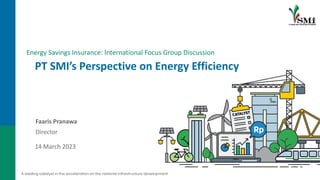
PT SMI's Role in Sustainable Finance and Energy Efficiency
- 1. PT SMI’s Perspective on Energy Efficiency Energy Savings Insurance: International Focus Group Discussion Faaris Pranawa Director 14 March 2023
- 2. PT Sarana Multi Infrastruktur (Persero) | 2 The Role of PT SMI in Sustainable Finance and Addressing Climate Change Sustainable Financing Establishing Sustainable Financing Division in 2016 Green Climate Fund (GCF) PT SMI is the First Accredited Entity in Southeast Asia Accreditation Size : Medium (up to 250 mill USD) SDG Indonesia One (SIO)1 In 2018, SIO was formed, a platform to support the achievement of SDGs, including climate change projects Green Bond & Impact Report Issued the first green bond in Indonesia Environmental and Social Safeguard (ESS) Framework Development and Implementation of the Guidelines of Environmental and Social Safeguard (ESS) Framework Energy Transition Mechanism (ETM) In 2022 appointed as the country platform Energy Transition Mechanism, an early retirement funding mechanism for PLTU and renewable energy financing SMI Institute The think tank formed by PT SMI, aims to provide research, capacity building and training policies, as well as outreach to help developing countries, especially in the infrastructure development sector, to achieve stronger, inclusive and sustainable growth. PT Sarana Multi Infrastruktur (Persero) was established in 2009 as a State-Owned Enterprise under the Ministry of Finance. PT SMI's business activities are regulated in the Financial Services Authority Regulation (“POJK”) concerning Infrastructure Financing Companies 1 2 3 4 7 6 5 1SIO Green Facility: ADB (150 mill USD loan) ; AFD (150 mill USD loan + 5.6 mill USD grant) ; GREM (197.5 mill USD loan + 122.5 mill USD reimbursable grant + 6.25 mill USD grant) ; UK Mentari (2.7 mill GBP grant) ; KfW (16.08 mill EUR grant)
- 3. PT Sarana Multi Infrastruktur (Persero) | 3 Energy Efficiency Market in Indonesia Untapped energy efficiency sectors: There is a huge potential for energy efficiency in Indonesia Electricity rates: Low electricity rates create low demand for energy efficiency projects and low return Awareness: Low awareness of energy efficiency technologies and opportunities Energy saving: Lack of understanding and confidence in energy saving Bankable projects: Limited bankable energy efficiency projects - Small project size - Securities - Existing lenders approvals Financing: No commercially attractive financing product for energy efficiency projects
- 4. PT Sarana Multi Infrastruktur (Persero) | 4 Financing Perspective on Energy Efficiency Guaranteed Saving Model Shared Saving Model • Uncertainty from energy saving, therefore, need to be guarantee or insurance by third party • Need bankable ESCO company (good track record and good financial statement) • Support in the form of incentive for Investment Grade Audit (IGA) for project owner • Corporate finance model can be an alternative to project finance model; however the energy efficiency asset is still included as underlying • Bundling of several projects into one facility, considering average projects are small sized projects, to reduce transaction cost Enhancement needed to support energy efficiency business model
- 5. ptsmi.co.id infralib.ptsmi.co.id @ptsmi ptsmi_id PT Sarana Multi Infrastruktur (Persero) Sahid Sudirman Center, Lantai 48 Jl. Jenderal Sudirman No. 86 Jakarta 10220, Indonesia Telepon : (62-21) 8082 5288 (hunting) Faksimile : (62-21) 8082 5258 Surel : corporatesecretary@ptsmi.co.id PT Sarana Multi Infrastruktur (Persero) Terima kasih,
- 6. PT Sarana Multi Infrastruktur (Persero) | 6 Risks in Energy Efficiency Projects RISK IMPACT LIKELIHOOD Economic and Financial: cost increases, interest rates, volatile energy prices, payment default High Medium Financial resources: limited calculations of risk and return, limit the supply of affordable capital and the demand for such investments. High Medium Behavioral and Operational: behavioral biases, rebound effect, faulty operation, unexpected consumption pattern Medium Low Awareness and commitment: lack of knowledge of EE, skepticism and misunderstanding of benefits, conflicting priorities, and a lack of motivation across businesses stymie the potential demand, lack of a convincing business case in contexts with cheap energy and absent regulation Medium Medium Measurement and Verification: Poor data quality, inconsistent measurement, modeling errors Medium Medium Technical solutions and expertise: Insufficient technical capacity, lack of commonality on best practice and standardization of procedures and technologies Medium Medium Contextual and Technology: Poor project design, installation delays, insufficient information on facility, poor equipment design, poor performance Medium Low Regulatory: Changes in grant/subsidy programs, unfavorable financial regulation, conflicting guidelines, changing regulation on financial market High Medium Environment: Risks related to the location, surrounding environment of the project Medium Low • Financial risk is perceived as the highest risk seen in energy efficiency projects, which is caused by small project size, limited financial capability of the ESCO company • Proven business model is needed to help in scaling up energy efficiency projects in Indonesia • De-risking instruments such as guarantee or insurance should be designed to increase credit rating and bankability of the project Source: Climate Policy Initiative, 2021
